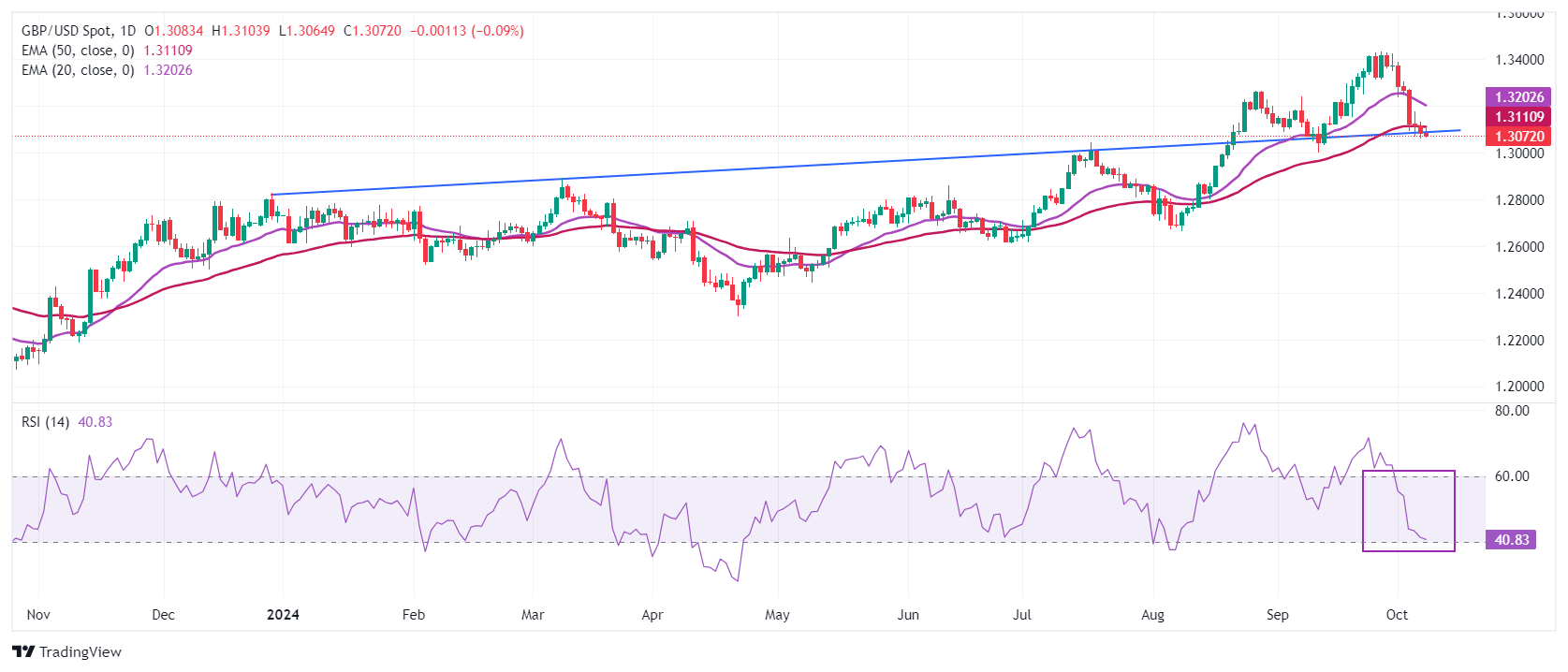- The British Pound remains vulnerable near 1.3060 against the US Dollar as investors expect the Fed to take a gradual approach to rate cuts.
- The Fed’s Williams hopes the central bank will be in no rush to cut interest rates quickly.
- Investors look to US CPI and UK GDP for fresh insights on interest rates.
The British Pound (GBP) struggles to gain ground near a three-week low of 1.3060 against the US Dollar (USD) on Tuesday. However, the near-term outlook for the GBP/USD pair remains fragile, as the US Dollar holds on to gains near a new seven-week high, with the US Dollar Index (DXY) trading around 102.50. The dollar strengthens as market participants are not pricing in another larger-than-usual 50 basis point (bp) interest rate cut by the Federal Reserve (Fed) in November.
The Fed began its policy easing cycle with a 50bp interest rate cut in September, primarily focusing on revitalizing labor market strength after gaining confidence that inflation will sustainably return to the bank’s 2% target. .
Market participants anticipated that the Fed would aggressively extend the rate cutting cycle. However, that speculation faded with upbeat United States (US) Nonfarm Payrolls (NFP) data for September, which showed a robust increase in labor hiring, a lower unemployment rate and an increase in salary growth.
Even though market speculation about large Fed rate cuts has subsided, the central bank is expected to remain on course to further ease monetary policy. Meanwhile, New York Fed President John Williams’ comments in an interview with the Financial Times on Tuesday have indicated that he favors a 25bp rate cut and is in no rush to cut interest rates. quickly, as the latest jobs data has increased their confidence in consumer spending and economic growth.
Looking ahead, investors will focus on US Consumer Price Index (CPI) data for September, due out on Thursday.
Daily Market Summary: Pound Trades Cautiously Amid Geopolitical Tensions
- The British pound trades cautiously against its major peers on Tuesday, with investors focused on tensions in the Middle East driving market sentiment. In Tuesday’s Asian session, Iran’s Foreign Minister Abbas Araqchi issued a warning to Israel that the nation will face strong retaliation if it tries to attack its infrastructure.
- The British currency is also under pressure as traders adjust market expectations on Bank of England (BoE) interest rates. Market participants expect the BoE to cut interest rates again in November. The BoE’s rate cut prospects rose sharply after comments last week from Governor Andrew Bailey, which indicated the central bank could cut interest rates aggressively if price pressures ease further.
- Inflation in the UK has remained persistent due to stubborn price pressures in the services sector amid stronger wage growth. Annual services inflation in the UK accelerated to 5.6% in August from 5.2% in July.
- This week, investors will pay close attention to the monthly gross domestic product (GDP) and factory data for August, which will be released on Friday. The data will provide new clues about current economic health.
Technical Analysis: The British Pound is trading below the 50-day EMA
The British pound is trading within Monday’s trading range, with investors focused on US CPI data for September. The GBP/USD pair is expected to remain on the defensive as it fails to hold the 50-day EMA, which is trading around 1.3100. Cable has weakened after falling below the ascending trend line from the December 28, 2023 high of 1.2827.
The 14-day Relative Strength Index (RSI) falls near 40.00. It would appear more bearish if the momentum oscillator falls below the level mentioned above.
Looking up, the round level resistance at 1.3100 and the 20-day EMA near 1.3202 will be a big barrier for the British Pound bulls. On the downside, the pair would find support near the psychological figure of 1.3000.
The British Pound FAQs
The British Pound (GBP) is the oldest currency in the world (886 AD) and the official currency of the United Kingdom. It is the fourth most traded currency unit in the world, with 12% of all transactions and an average of $630 billion per day, according to 2022 data.
Its key currency pairs are GBP/USD, also known as “Cable”, which represents 11% of the forex market, GBP/JPY, or the “Dragon” as it is known to traders (3%), and EUR/GBP (2%). The pound sterling is issued by the Bank of England (BoE).
The most important factor influencing the value of the Pound Sterling is the monetary policy decided by the Bank of England. The Bank of England bases its decisions on achieving its main objective of “price stability”, that is, a stable inflation rate of around 2%. Its main tool to achieve this is the adjustment of interest rates.
When inflation is too high, the Bank of England tries to contain it by raising interest rates, which makes access to credit more expensive for individuals and companies. This tends to be positive for the GBP, as higher interest rates make the UK a more attractive place for global investors to park their money.
When inflation is too low, it is a sign that economic growth is slowing. In this scenario, the BoE will consider lowering interest rates to make credit cheaper, so that companies borrow more to invest in projects that generate growth.
The published data gauges the health of the economy and may influence the value of the Pound sterling. Indicators such as GDP, manufacturing and services PMIs, and employment can influence the direction of the Pound.
A strong economy is good for the British pound. Not only does it attract more foreign investment, but it may encourage the Bank of England to raise interest rates, which will directly strengthen the Pound. Otherwise, if economic data is weak, the pound is likely to fall.
Another significant data for the pound sterling is the trade balance. This indicator measures the difference between what a country earns from its exports and what it spends on imports during a given period.
If a country produces highly sought-after exports, its currency will benefit exclusively from the additional demand created by foreign buyers wishing to purchase these goods. Therefore, a positive net trade balance strengthens a currency and vice versa for a negative balance.
Source: Fx Street
I am Joshua Winder, a senior-level journalist and editor at World Stock Market. I specialize in covering news related to the stock market and economic trends. With more than 8 years of experience in this field, I have become an expert in financial reporting.








